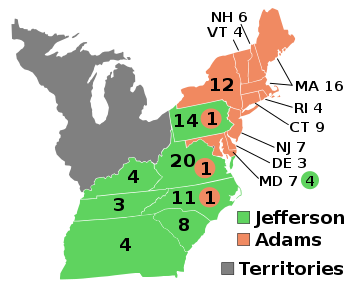
Back انتخابات الرئاسة الأمريكية 1796 Arabic ABŞ-də prezident seçkiləri (1796) Azerbaijani Volby prezidenta USA 1796 Czech Præsidentvalget i USA 1796 Danish Präsidentschaftswahl in den Vereinigten Staaten 1796 German Elecciones presidenciales de Estados Unidos de 1796 Spanish انتخابات ریاستجمهوری ایالات متحده آمریکا (۱۷۹۶) Persian Yhdysvaltain presidentinvaalit 1796 Finnish Élection présidentielle américaine de 1796 French הבחירות לנשיאות ארצות הברית 1796 HE
| |||||||||||||||||||||||||||||
138 members of the Electoral College[a] 70 electoral votes needed to win | |||||||||||||||||||||||||||||
|---|---|---|---|---|---|---|---|---|---|---|---|---|---|---|---|---|---|---|---|---|---|---|---|---|---|---|---|---|---|
| Turnout | 20.1%[1] | ||||||||||||||||||||||||||||
| |||||||||||||||||||||||||||||
 Presidential election results map. Green denotes states won by Jefferson and Orange denotes states won by Adams. Numbers indicate the number of electoral votes cast by each state. | |||||||||||||||||||||||||||||
| |||||||||||||||||||||||||||||
The 1796 United States presidential election was the third quadrennial presidential election of the United States. It was held from Friday, November 4 to Wednesday, December 7, 1796. It was the first contested American presidential election, the first presidential election in which political parties played a dominant role, and the only presidential election in which a president and vice president were elected from opposing tickets. Incumbent vice president John Adams of the Federalist Party defeated former secretary of state Thomas Jefferson of the Democratic-Republican Party.
With incumbent president George Washington having refused a third term in office, the 1796 election became the first U.S. presidential election in which political parties competed for the presidency. The Federalists coalesced behind Adams and the Democratic-Republicans supported Jefferson, but each party ran multiple candidates. Under the electoral rules in place prior to the Twelfth Amendment, the members of the Electoral College each cast two votes, with no distinction made between electoral votes for president and electoral votes for vice president. The individual with the votes of a majority of electors became president, and the runner-up became vice president. If there was a tie for first place or no person won a majority, the House of Representatives would hold a contingent election. Also, if there were a tie for second place, the vice presidency, the Senate would hold a contingent election to break the tie.
The campaign was a bitter one, with Federalists attempting to identify the Democratic-Republicans with the violence of the French Revolution[2] and the Democratic-Republicans accusing the Federalists of favoring monarchism and aristocracy. Republicans sought to associate Adams with the policies developed by fellow Federalist Alexander Hamilton during the Washington administration, which they declaimed were too much in favor of Great Britain and a centralized national government. In foreign policy, Republicans denounced the Federalists over the Jay Treaty, which had established a temporary peace with Great Britain. Federalists attacked Jefferson's moral character, alleging he was an atheist and that he had been a coward during the American Revolutionary War. Adams supporters also accused Jefferson of being too pro-France; the accusation was underscored when the French ambassador embarrassed the Republicans by publicly backing Jefferson and attacking the Federalists right before the election.[3] Despite the hostility between their respective camps, neither Adams nor Jefferson actively campaigned for the presidency.[4][3]
Adams was elected president with 71 electoral votes, one more than was needed for a majority. He won by sweeping the electoral votes of New England and winning votes from several other swing states, especially the states of the Mid-Atlantic region. Jefferson received 68 electoral votes and was elected vice president. Former governor Thomas Pinckney of South Carolina, a Federalist, finished with 59 electoral votes, while Senator Aaron Burr, a Democratic-Republican from New York, won 30 electoral votes. The remaining 48 electoral votes were dispersed among nine other candidates. Several electors cast one vote for a Federalist candidate and one for a Democratic-Republican. The election marked the formation of the First Party System, and established a rivalry between Federalist New England and the Democratic-Republican South, with the middle states holding the balance of power (New York and Maryland were the crucial swing states, and between them only voted for a loser once between 1789 and 1820).[5]
Cite error: There are <ref group=lower-alpha> tags or {{efn}} templates on this page, but the references will not show without a {{reflist|group=lower-alpha}} template or {{notelist}} template (see the help page).
- ^ "National General Election VEP Turnout Rates, 1789-Present". United States Election Project. CQ Press.
- ^ Presidential Election of 1796, retrieved on November 5, 2009.
- ^ a b "John Adams: Campaigns and Elections—Miller Center". millercenter.org. Retrieved April 15, 2016.
- ^ "Inside America's first dirty presidential campaign, 1796 style". Constitution Daily. Archived from the original on February 14, 2017. Retrieved April 15, 2016.
- ^ Jeffrey L. Pasley, The First Presidential Contest: 1796 and the Founding of American Democracy (2013)

